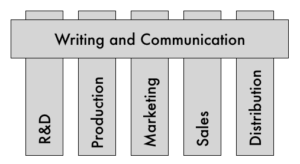Communication is the lifeblood of professional life. Whatever their specialized knowledge, skills, or tasks, people need to communicate with colleagues and clients inside and outside the organization.
How can we understand the power of communication?
McKinsey consultants use the “T” model to describe their work. The vertical bars (|) represent the activities of distinct operations of the enterprise: R&D, production, marketing, sales, distribution, and more. The crossbar (—) represents the need to communicate and connect with people outside their primary operations
Workers—especially in technical, specialized fields or with large corporate structures—usually focus on the activities inside their specialized roles. That makes sense. In cutting-edge fields and legacy businesses alike, competitive value comes from specialists doing things that other people can’t do. Special knowledge and ability offer special value to the company.
No matter how good the work they do inside their “I” silos, the best organizations foster connections across the silos. They create crossbars that connect people across the organization, especially at the top and middle levels. Only by keeping each other posted on new issues and developments can the organization coordinate its activities.
The Six Essential Skills
So how does this horizontal communication occur? To work at optimal levels, professionals need to master six essential communications skills: Conversations, Interviews, Presentations, Emails, Memos and Reports, Public-facing communications.
The Elements of Writing provides a complete program for business professionals to master all six of the communications skills. The program includes not only seminars and workshops on these essential skills, but also followup guidance for managers to bring their teams into the fold.
Conversations—Connecting / Empathy
Conversation is the essential lubrication of business—whether you’re managing a department, selling products and services, or working on a project. A British survey found that people have 27 conversations a day, lasting an average of 10 minutes apiece. That’s 270 minutes—four and a half hours. Americans might be more taciturn (yeah, right), but talking will always be at the center of professional life.
Interviews—Digging / Curiosity
The more detail and insight you need, the more you need to dig. That’s where interviews come in. An interview is a structured, goal-oriented conversation. Unlike conversations, interviews tend to be one-sided. One side’s needs matter more than the other’s. A good interview is less a give-and-take and more a process of step-by-step discovery, which requires deliberate followup, strategic issue-hopping, clarifications, and connecting dots.
Presentations—Highlighting / 2+2 Rule
A presentation is a conversation of many, led by one or a few people. The trick is to present material that “lands and leads.” As filmmakers understand, an audience can absorb only so much information at a time. So the speaker must provide information in small doses; if the information “lands,” the audience can absorb that information and make sense of it in their own way, for their own purposes. And the presenter can lead the group in productive ways.
Emails: Acting / Conciseness
Emails are like nudges, with simple presentations of essential information for action. The key to writing good emails is clarity of purpose. Because business professionals take in hundreds of emails a day, they need to understand the purpose by reading the header—and then efficiently read only essential information about one idea in every email.
Memos and Reports—Signposting and Detailing / Organizing and Unfolding
Memos and reports are take-away pieces with one idea but multiple parts. They require thought and reflection, often among many people. A good memo states the One Idea clearly and then organizes the whole piece to state and detail all of the essential considerations for that One Idea. Good memos and reports organize information logically, with clear signposts for skimmers. (Note: All readers are skimmers)
Public Pieces—Reaching Out / Engagement
Communication with outsiders differs from communication with insiders. Public-facing pieces must be, at the same time, more intimate and more general than inside pieces. They must speak to the audience with personality—with concern, empathy, a desire to help, and (often) a dash of humor. So whether you’re writing a speech or a blog post, it helps to imagine one person in the audience. At the same time, the piece must appeal to a vast audience. This requires thinking of all the issues and concerns that your one imaginary person might need or want to know about. It also requires understanding their time frame. Web copy might require extreme conciseness, while a speech could engage the audience for 30 minutes or more.
What next? During the strange separations of the coronavirus pandemic, businesses offer their professionals online programs to improve their skills across the board. Writing and communication should be at the top of the agenda.


